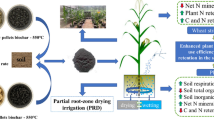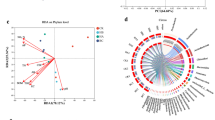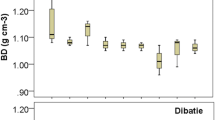Abstract
Purpose
Polymer materials positively affect the physical, chemical, and microbiological properties of soil. However, little is known about the response mechanism of soil carbon and nitrogen transformation to polymer materials.
Methods
This study explored the effects of three polymer materials (humic acid extracted from cottonseed meal, H; modified polymer prepared by using polyacrylamide as main raw material, P; and composite polymer material composed of humic acid and modified polymer, HP) on the soil physicochemical properties, organic carbon (TOC), total nitrogen (TN), carbon and nitrogen fractions, and bacterial community structure in planted and non-planted soils under drip irrigation.
Results
The results showed that the application of H and P reduced soil bulk density (BD), improved soil aggregate stability (including soil aggregates > 0.25 mm, R0.25; mean weight diameter, MWD; and mean geometric diameter, GWD), and increased the content of TOC, TN, and carbon and nitrogen fractions (including labile organic carbon content, LOC; soil carbon management index, CMI; NO3−-N; NH4+-N; microbial biomass carbon, MBC; microbial biomass nitrogen, MBN). Polymer materials all could increase the diversity of bacterial communities, especially H (the diversity of bacterial communities in H treatment was 1.8% and 2.4% higher than that in the CK in planted and non-planted soil, respectively (p < 0.05)).
Conclusions
The application of H and P reduced soil BD, and improved soil R0.25, MWD, GWD, TOC, TN, LOC, CMI, NO3−-N, NH4+-N, MBC, and MBN. Redundancy analysis (RDA) showed that the application of H and P improved soil TOC, TN, and carbon and nitrogen fractions by increasing the water stability of soil aggregate, and the increase of soil MBN indirectly improved the bacterial community structure.




Similar content being viewed by others
References
Abu-Hamdeh NH, Ismail SM, Al-Solaimani SG et al (2019) Effect of tillage systems and polyacrylamide on soil physical properties and wheat grain yield in arid regions differing in fine soil particles. Arch Agron Soil Sci 65:182–196. https://doi.org/10.1080/03650340.2018.1492114
Albalasmeh AA, Hamdan EH, Gharaibeh MA et al (2021) Improving aggregate stability and hydraulic properties of sandy loam soil by applying polyacrylamide polymer. Soil till Res 206:104821. https://doi.org/10.1016/j.still.2020.104821
Anderson JE, Domsch KH (1978) Mineralization of bacteria and fungi in chloroform fumigated soils. Soil Biol Biochem 10:207–213. https://doi.org/10.1016/0038-0717(78)90098-6
Blair GJ, Lefroy RDB, Lisle L (1995) Soil carbon fractions based on their degree of oxidation, and the development of a carbon management index for agricultural systems. Crop Pasture Sci 46:1459–1466. https://doi.org/10.1071/AR9951459
Bouranis DL, Theeodoropoutos AG (1995) Designing synthetic polymers as soil conditioner. Commun Soi Soc Plant Anal 21:1455–1480. https://doi.org/10.1080/00103629509369384
Brookes PC, Landman A, Pruden G et al (1985) Chloroform fumigation and the release of soil nitrogen: a rapid direct extraction method to measure microbial biomass nitrogen in soil. Soil Biol Biochem 17:837–842. https://doi.org/10.1016/0038-0717(85)90143-9
Carter MR (1993) Soil sampling and methods of analysis Canadian Society of Soil Science. Lewis Publishers, Boca Raton
Cavalcante JS, Favaretto N, Dieckow J et al (2019) Long-term surface application of dairy liquid manure to soil under no-till improves carbon and nitrogen stocks. Eur J Soil Sci. https://doi.org/10.1111/ejss.12920
Chen DM, Lan ZC, Hu SJ et al (2015) Effects of nitrogen enrichment on belowground communities in grassland: relative role of soil nitrogen availability vs soil acidification. Soil Biol Biochem 89:99–108. https://doi.org/10.1016/j.soilbio.2015.06.028
Chu H, Fierer N, Lauber CL et al (2010) Soil bacterial diversity in the Arctic is not fundamentally different from that found in other biomes. Environ Microbiol 12:2998–3006. https://doi.org/10.1111/j.1462-2920.2010.02277.x
Crooke WM, Simpson W (1971) Determination of ammoniumin Kjeldahl extracts of crops by an automated procedure. J Sci Food Agr 22:9–10. https://doi.org/10.1002/jsfa.2740220104
Diekow J, Mielniczuk J, Knicker H et al (2005) Carbon and nitrogen stocks in physical fractions of a subtropical acrisol as influenced by long-term no-till crop** systems and N fertilization. Plant Soil 268:319–328. https://doi.org/10.1007/s11104-004-0330-4
Green VS, Stott DE, Graveel JG et al (2004) Stability analysis of soil aggregates treated with anionic polyacrylamides of different molecular formulations. Soil Sci 169:573–581. https://doi.org/10.1097/01.ss.0000138416.30169.3f
Hu X, Liu LY, Li SJ et al (2012) Development of soil crusts under simulated rainfall and crust formation on a Loess soil as influenced by polyacrylamide. Pedosphere 22:415–424. https://doi.org/10.1016/s1002-0160(12)60027-7
Islam MR, Hu YG, Fei C et al (2011) Application of superabsorbent polymer: a new approach for wheat (Triticum aestivum L.) production in drought-affected areas of northern China. J Food Agr Environ 9:304–309. https://doi.org/10.3168/jds.2011-94-1-537
Jackson ML (1973) Soil Chemical Analysis, 2nd edn. Prentice-Hall, Englewood
Kumar A, Saha A (2011) Effect of polyacrylamide and gypsumon surface runoff, sediment yield and nutrient lossesfrom steep slopes. Agric Water Manag 98:999–1004. https://doi.org/10.1016/j.agwat.2011.01.007
Lentz RD (2015) Polyacrylamide and biopolymer effects on flocculation, aggregate stability, and water seepage in a silt loam. Geoderma 241(242):289–294. https://doi.org/10.1016/j.geoderma.2014.11.019
Li X, He JZ, Liu YR et al (2013) Effects of super absorbent polymers on soil microbial properties and Chinese cabbage (Brassica chinensis) growth. J Soil Sediment 13:711–719. https://doi.org/10.1007/s11368-013-0657-7
Li YF, Li JZ, Hughes JM et al (2014) Effects of super-absorbent polymers on a soil–wheat (Triticum aestivum L.) system in the field. Appl Soil Ecol 73:58–63. https://doi.org/10.1016/j.apsoil.2013.08.005
Lu S, Chen F, Ngo HH et al (2016) Effect of straw and polyacrylamide on the stability of land/water ecotone soil and the field implementation. Ecol Eng 94:12–21. https://doi.org/10.1016/j.ecoleng.2016.05.076
Ma L, Jiang XL, Liu GH et al (2020) Environmental factors and microbial diversity and abundance jointly regulate soil nitrogen and carbon biogeochemical processes in Tibetan wetlands. Environ Sci Technol 54:3267–3277. https://doi.org/10.1021/acs.est.9b06716
Madhav PT, Milcu A, Manning P et al (2015) Plant diversity drives soil microbial biomass carbon in grasslands irrespective of global environmental change factors. Glob Chang Biol 21:4076–4085. https://doi.org/10.1111/gcb.13011
Nelson DW, Sommers LE (1982) Total carbon, organic carbon, organic matter. In: Page AL (ed) Methods of Soil Analysis. Wis-consin, USA 539–579
O’’Brien SL, Jastrow JD (2013) Physical and chemical protection in hierarchical soil aggregates regulates soil carbon and nitrogen recovery in restored perennial grasslands. Soil Biol Biochem 61:1–13. https://doi.org/10.1016/j.soilbio.2013.01.031
Sepaskhah AR, Bazrafshan-JaHromi AR (2006) Controlling runoff and erosion in slo** land with polyscrylamide under a rainfall simulator. Biosyst Eng 93:469–474. https://doi.org/10.1016/j.biosystemseng.2006.01.003
Sojka RE, Entry A, Furhmann JJ (2006) The influence of high application rates of polyacrylamide on microbial metabolic potential in an agricultural soil. Appl Soil Ecol 32:243–252. https://doi.org/10.1016/j.apsoil.2005.06.007
Su YO, Kumar S (2016) Effects of polyhydroxyalkanoate degradation on soil microbial community. Polym Degrad Stabil 131:9–19. https://doi.org/10.1016/j.polymdegradstab.2016.06.024
Suntari R, Retnowati R, Soemarno S et al (2015) Determination of urea-humic acid dosage of vertisols on the growth and production of rice. Agrivita J Agr Sci 37:185–192. https://doi.org/10.17503/Agrivita-2015-37-2-p185-192
Tian XM, Fan H, Wang JQ et al (2019) Effect of polymer materials on soil structure and organic carbon under drip irrigation. Geoderma 340:94–103. https://doi.org/10.1016/j.geoderma.2018.12.038
Tian XM, Wang KY, Liu YH et al (2020) Effects of polymer materials on soil physicochemical properties and bacterial community structure under drip irrigation. Appl Soil Ecol 150:103456. https://doi.org/10.1016/j.apsoil.2019.103456
Vance ED, Brookes PC, Jenkinson DS (1987) An extraction method for measuring microbial biomass C. Soil Biol Biochem 22:703–707. https://doi.org/10.1016/0038-0717(87)90052-6
Walkley A, Black IA (1934) An examination of the Degtjareff method for determining soil organic matter, and a proposed modification of the chromic acid titration method. Soil Sci 37:29–38. https://doi.org/10.1097/00010694-193401000-00003
Wang T, Kang F, Cheng X et al (2016) Soil organic carbon and total nitrogen stocks under different land uses in a hilly ecological restoration area of North China. Soil till Res 163:176–184. https://doi.org/10.1016/j.agee.2014.02.035
Wang Z, Yang Y, **a Y et al (2019) Time-course relationship between environmental factors and microbial diversity in tobacco soil. Sci Rep-Uk 9:19969. https://doi.org/10.1038/s41598-019-55859-4
Wu L, Ok YS, Xu XL et al (2011) Effects of anionic polyacrylamide on maize growth: a short term 14C labeling study. Plant Soil 350:311–322. https://doi.org/10.1007/s11104-011-0911-y
Yang XM, Wander MM (1998) Temporal changes in dry aggregate size and stability: tillage and crop effects on a silty loam Mollisol in Illinois. Soil till Res 49:173–183. https://doi.org/10.1016/S0167-1987(98)00170-6
Zeller B, Liu JX, Buchmann N et al (2008) Tree girdling increases soil N mineralization in two spruce stands. Soil Biol Biochem 40:1155–1166. https://doi.org/10.1016/j.soilbio.2007.12.009
Zhao YJ, Liu B, Zhang WG et al (2010) An Effects of plant and influent C: N: P ratio on microbial diversity in pilot-scale constructed wetlands. Ecol Eng 36:441–449. https://doi.org/10.1016/j.ecoleng.2009.11.011
Zhou H, Peng X, Perfect E et al (2013) Effects of organic and inorganic fertilization on soil aggregation in an Ultisol as characterized by synchrotron based X-ray micro-computed tomography. Geoderma 195:23–30. https://doi.org/10.1016/j.geoderma.2012.11.003
Funding
This study is funded by the S&T Program of Hebei (21326405D, 21326302D), the Natural Science Foundation of Hebei (D2020405002), and the Hebei North University level project (JYT2021003).
Author information
Authors and Affiliations
Corresponding author
Ethics declarations
Ethics Approval
All procedures performed in studies involving human participants were in accordance with the ethical standards of the institutional and/or national research committee and with the 1964 Helsinki declaration and its later amendments or comparable ethical standards.
Informed Consent
Informed consent was obtained from all individual participants included in the study.
Conflict of Interest
The authors declare no competing interests.
Additional information
Publisher's Note
Springer Nature remains neutral with regard to jurisdictional claims in published maps and institutional affiliations.
Rights and permissions
About this article
Cite this article
Tian, X., Liu, Y., Wang, K. et al. Response Mechanism of Soil Carbon and Nitrogen Transformation to Polymer Materials Under Drip Irrigation. J Soil Sci Plant Nutr 22, 1351–1361 (2022). https://doi.org/10.1007/s42729-021-00737-0
Received:
Accepted:
Published:
Issue Date:
DOI: https://doi.org/10.1007/s42729-021-00737-0




